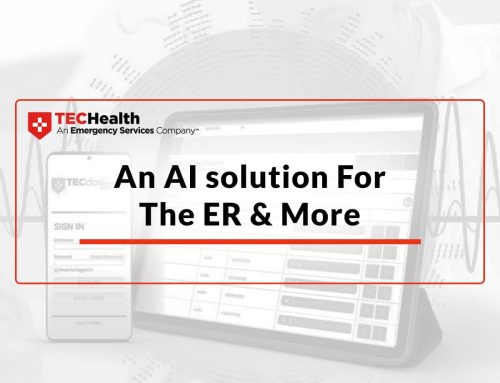Generative AI Improving Healthcare Efficiency: Reducing Physician Burnout & Streamlining Medical Documentation
Despite all the current buzz around artificial intelligence in healthcare, the technology has played a meaningful role in medicine for over a decade now. Historically, its use has been narrowly focused, most commonly in Radiology as a ‘second set of eyes’ for imaging studies.
That’s changed rapidly though with the introduction of generative AI and tools built on generative AI platforms like TECdoc Scribe.

How Generative AI is Alleviating Healthcare’s Administrative Burden
“I expect there still to be a very, very healthy field of narrow AI in a lot of different applications of medicine, but right now, it’s all about generative AI,” according to Matt Lungren, MD, chief medical information officer at Microsoft+Nuance, who shared his thoughts on AI in medicine with TECHealth Chief Operations Officer Eric Wilke, MD, on the Vital Visions podcast.
That’s because with generative AI-based technologies, for the first time, there’s a real path forward for solving a major global pain point in healthcare: the documentation burden. This burden is heavily tied to electronic medical record (EMR) usage and, according to research, a leading driver of another major issue in healthcare: clinician burnout.
“Where I really see the true impact at least in the near term—and there’s a lot of work to do—is in some of the administrative tasks,” explained Dr. Lungren. “When [doctors] are spending 18-plus hours a week on non-clinical care tasks—meaning documentation and non-clinical care administrative tasks—to me, there’s no excuse [for not] driving towards those use cases almost as a first step.”
TECdoc Scribe was designed precisely with this goal in mind.
How Generative AI Can Save Physicians Time and Improve Efficiency
A large study in the Annals of Internal Medicine found that physicians spent more than 16 minutes using the EMR for each patient they see. While time spent documenting has been an enduring issue and the subject of exhaustive analysis and attempted solutions over many years, almost nothing has moved the needle thus far.
“Before this technology came on to the scene,” said Dr. Lungren, “this was a really hard problem to solve.”
Now, solutions like TECdoc Scribe can do most the documentation for physicians. TECdoc Scribe is a simple, effective application that only takes a few minutes to set-up and streamlines the documentation process with a few simple steps:
- Start recording using the TECdoc Scribe app. The app will collect all clinically relevant information.
- Speak to/evaluate your patient with your full attention. TECdoc Scribe operates in the background, eliminating the need to take notes.
- Export AI-generated drafts in seconds to any EMR after reviewing and add any other data by talking to the app or taking a picture (e.g., lab results).
Streamlining Documentation: How TECdoc Scribe Revolutionizes Patient Charting
TECdoc Scribe doesn’t simply summarize patient conversations. It’s smart enough to collaborate with physicians in patient care.
“I could have a five-minute discussion with the patient about last night’s basketball game before talking about their abdominal pain and none of our discussion about the game shows up in the chart,” explains Dr. Wilke.
Moreover, it continuously updates the patient chart with new interactions and data, as well as:
- Automatically generates a differential diagnosis
- Recognizes and assigns ICD-10 codes
- Generates CPT codes for billing
- Follows CMS documentation guidelines
It also can provide reminders and recommendations, helping ensure the physician doesn’t miss a rare or critical finding.
The Future of AI in Healthcare: TECdoc Scribe as a Starting Point for Innovation
TECdoc Scribe is a giant leap forward in curtailing physician EMR fatigue and allowing physicians to spend their focus and energy on the patient.
“Most of the feedback we’re getting is that it’s a huge timesaver,” says Dr. Wilke. But he adds that it’s not a one-and-done solution. His team is making it even better as the scale and scope of AI expands to add even more functionality and tailor it to various specialties and clinical settings based largely on feedback from clinical end-users.
“You almost have to reassess every couple of months to look at what’s happening in the AI sphere,” he says, “because that can change a feature set or give us the chance to make it more robust.”
While the AI revolution in medicine may still be in its infancy, TECdoc Scribe is set to help clinical users thrive as it grows up.
Try TECdoc Scribe: A Free Trial to Experience AI-Driven Healthcare Documentation
Want a bedside technology that actually allows you to put the human touch back into healthcare? Visit TECdoc.ai for more details and a link to a free, no-obligation trial of TECdoc Scribe.




